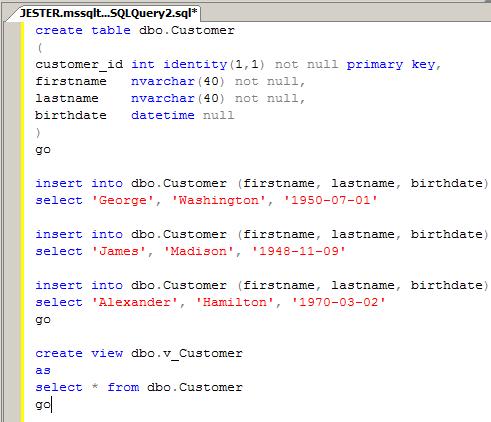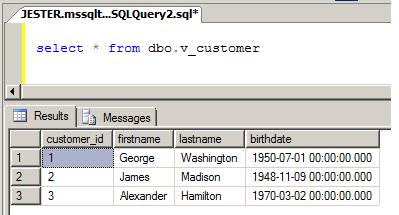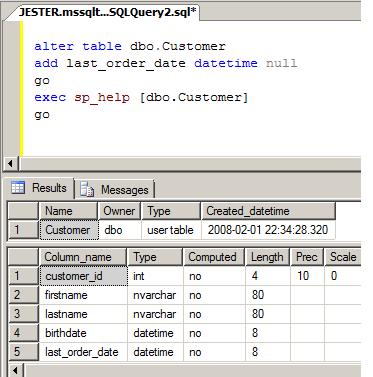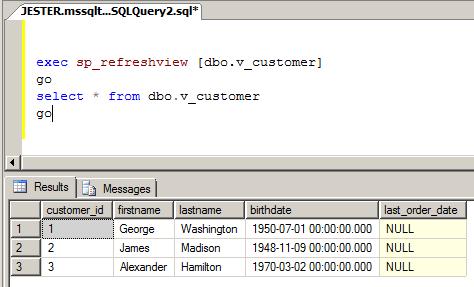A view is a virtual table that means it does not contain any physical data. A view is nothing more than a compiled SQL query. Every time, we issue a select query against a view, we actually get the data from the underlying base tables and not from the view, as the view itself does not contain any data.
When we create an index on a view, the data gets physically stored in the view. So, when we issue a select query against an indexed view, the data is retrieved from the index without having to go to the underlying table, which will make the select statement to work slightly faster. However, the disadvantage is INSERT, UPDATE and DELETE operations will become a little slow, because every time we insert or delete a row from the underlying table, the view index needs to be updated. In short, DML operations will have a negative impact on performance.
Oracle refers to indexed views as materialized views.
Only the views created with schema binding can have an Index. Simply adding WITH SCHEMABINDING to the end of the CREATE VIEW statement will accomplish this. However, the effect is that any changes to the underlying tables which will impact the view are not allowed. Since the indexed view is stored physically, any schema changes would impact the schema of the stored results set. Therefore, SQL Server requires that schema binding is used to prevent the view’s schema (and therefore the underlying tables) from changing.
The first index for a view must be a UNIQUE CLUSTERED INDEX, after which, it’s possible to create non-clustered indexes against the view.
Indexed Views are heavily used in data warehouses and reporting databases that are not highly transactional.
Let's now, look at an example of creating an Indexed view. For the purpose of this video, we will be using tblProduct and tblProductSales tables.
Script to create table tblProduct
Create Table tblProduct
(
ProductId int primary key,
Name nvarchar(20),
UnitPrice int
)
Script to pouplate tblProduct, with sample data
Insert into tblProduct Values(1, 'Books', 20)
Insert into tblProduct Values(2, 'Pens', 14)
Insert into tblProduct Values(3, 'Pencils', 11)
Insert into tblProduct Values(4, 'Clips', 10)
Script to create table tblProductSales
Create Table tblProductSales
(
ProductId int,
QuantitySold int
)
Script to pouplate tblProductSales, with sample data
Insert into tblProductSales values(1, 10)
Insert into tblProductSales values(3, 23)
Insert into tblProductSales values(4, 21)
Insert into tblProductSales values(2, 12)
Insert into tblProductSales values(1, 13)
Insert into tblProductSales values(3, 12)
Insert into tblProductSales values(4, 13)
Insert into tblProductSales values(1, 11)
Insert into tblProductSales values(2, 12)
Insert into tblProductSales values(1, 14)
tblProduct Table

tblProductSales Table

Create a view which returns Total Sales and Total Transactions by Product. The output should be, as shown below.

Script to create view vWTotalSalesByProduct
Create view vWTotalSalesByProduct
with SchemaBinding
as
Select Name,
SUM(ISNULL((QuantitySold * UnitPrice), 0)) as TotalSales,
COUNT_BIG(*) as TotalTransactions
from dbo.tblProductSales
join dbo.tblProduct
on dbo.tblProduct.ProductId = dbo.tblProductSales.ProductId
group by Name
If you want to create an Index, on a view, the following rules should be followed by the view. For the complete list of all rules, please check MSDN.
1. The view should be created with SchemaBinding option
2. If an Aggregate function in the SELECT LIST, references an expression, and if there is a possibility for that expression to become NULL, then, a replacement value should be specified. In this example, we are using, ISNULL() function, to replace NULL values with ZERO.
3. If GROUP BY is specified, the view select list must contain a COUNT_BIG(*) expression
4. The base tables in the view, should be referenced with 2 part name. In this example, tblProduct and tblProductSales are referenced using dbo.tblProduct and dbo.tblProductSales respectively.
Now, let's create an Index on the view:
The first index that you create on a view, must be a unique clustered index. After the unique clustered index has been created, you can create additional nonclustered indexes.
Create Unique Clustered Index UIX_vWTotalSalesByProduct_Name
on vWTotalSalesByProduct(Name)
Since, we now have an index on the view, the view gets materialized. The data is stored in the view. So when we execute Select * from vWTotalSalesByProduct, the data is retrurned from the view itself, rather than retrieving data from the underlying base tables.
Indexed views, can significantly improve the performance of queries that involves JOINS and Aggeregations. The cost of maintaining an indexed view is much higher than the cost of maintaining a table index.
Indexed views are ideal for scenarios, where the underlying data is not frequently changed. Indexed views are more often used in OLAP systems, because the data is mainly used for reporting and analysis purposes. Indexed views, may not be suitable for OLTP systems, as the data is frequently addedd and changed.
Ref:
https://csharp-video-tutorials.blogspot.com/2012/09/indexed-views-in-sql-server-part-41.html








